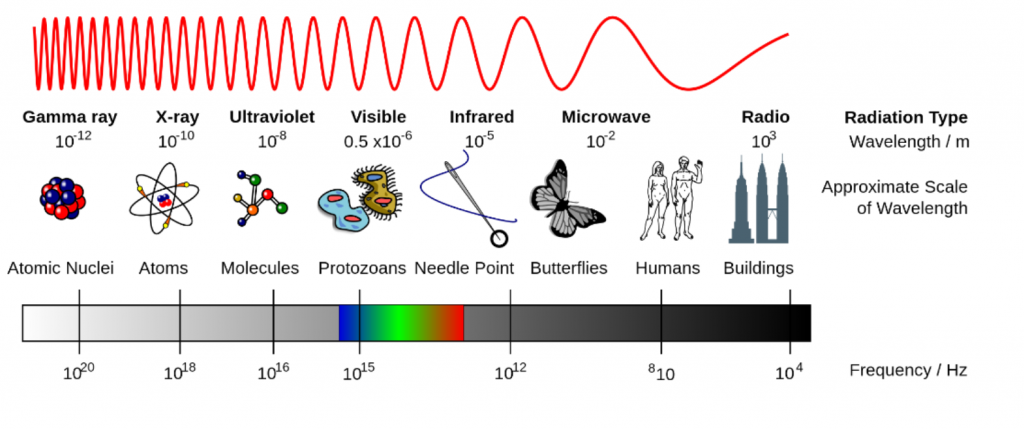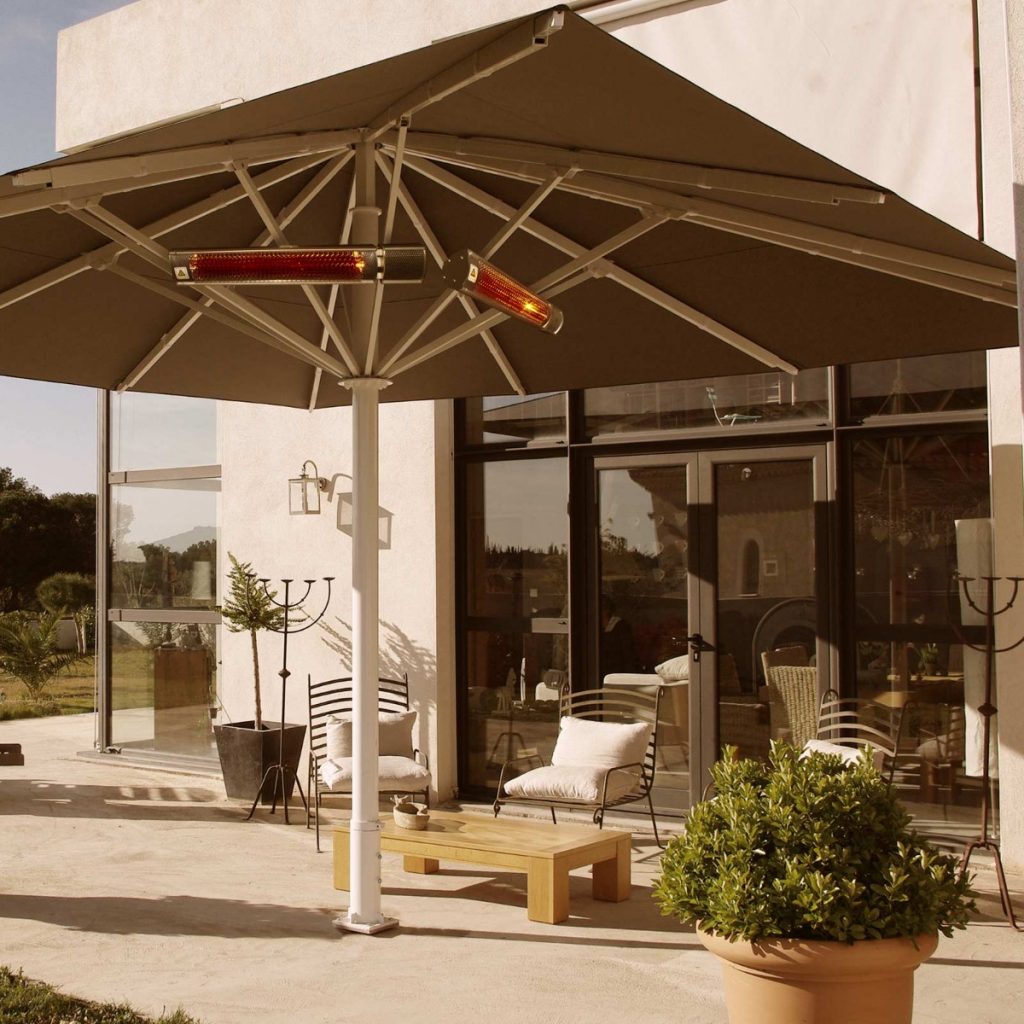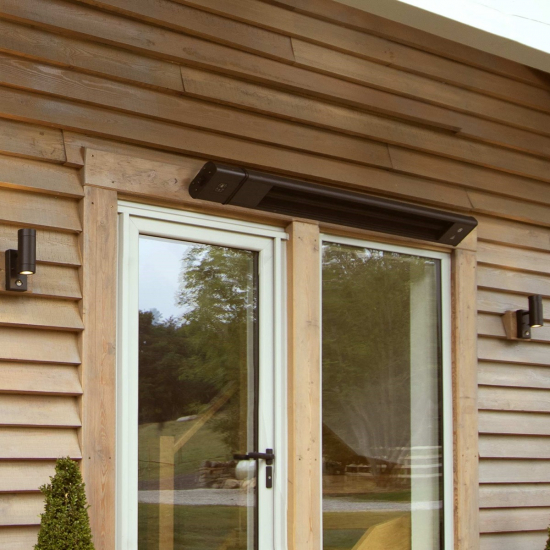Terms commonly used throughout our website, near and far infrared, are two kinds of heat transfer. Delivering comfort on different levels, they both make use of the direct, stable and even warmth of infrared radiation. Whilst their names may sound self-explanatory, near and far infrared have a range of individual benefits making them better for some environments over others. Here, we’re getting into the nitty-gritty of near and far infrared, their respective pros and cons, and our top heater picks.
What is the electromagnetic spectrum?
The electromagnetic spectrum is the term used to describe the entire range of light that exists. It’s not limited to the colours of the rainbow – there are various forms of light that aren’t visible to the human eye. In fact, the kinds we can see are only a tiny portion of the total amount of light out there. The electromagnetic spectrum begins with radio waves and ends with gamma rays, and in between are microwaves, visible light and infrared radiation.

What is infrared radiation?
Infrared is a type of radiant energy that’s invisible to us, but our bodies can perceive it as heat. All objects give off some level of infrared radiation – even really cold ones, like ice cubes. Infrared is what’s at play when a pavement is radiating heat on a hot day, or when you get a wave of warmth once the sun comes out from behind a cloud.
What is near infrared?
Near infrared is the closest form of infrared to the visible light spectrum, which is why near infrared heaters often have a ruby glow. Near infrared has a short wavelength but a high frequency – meaning it is the most intense form of infrared, as its infrared waves are emitted at the quickest speed, generating the most energy.
Benefits of near infrared for home & garden heating
- Instantaneous warmth
Springing to life in seconds, near infrared heaters are brilliant for spaces that need heat quickly. Most near infrared heaters heat up in a matter of seconds, making them an excellent choice for outdoor locales or indoor spaces that only need heat sporadically.
- Invigorating heat regardless of airflow

Near infrared works by emitting waves of warmth towards people and objects. It does not rely on heating the whole body of air in a room, like convection heaters do – and so, ambient temperatures are immaterial to a near infrared heater. It will warm people thoroughly regardless of how cold the air feels – making it a type of heat transfer that’s both effective and efficient.
- Can be used indoors or outdoors
Unlike far infrared, near infrared heaters have both indoor and outdoor applications. As the type of heat it produces is somewhat intense, any location that needs an extra boost of heat on a more infrequent basis will benefit from a near infrared heater – they are less limited when it comes to installation.
Disadvantages of near infrared for home & garden heating
- It can become overwhelming over longer periods
As near infrared has a high frequency, it produces heat which feels impacting and energising. Ideal for short term use, it can begin to feel too intense after an extended period, making it unsuitable for all-day or long-term use.
- Near infrared emits light
Being so close to the visible light spectrum, near infrared generally produces a ruby glow. Our near infrared heaters are not so bright they produce glare, but it’s worth bearing in mind if you’re likely to find their mellow rays distracting. If you’re a glass-half-full type though, the reddish gleam can double up as some handy mood lighting.
- It does not absorb as well
Humans absorb infrared the best when it has a longer wavelength. Near infrared has the shortest wavelength, and so it is the least well-absorbed of the three. This means the type of heat a near infrared unit produces is not as durable, so when the heater is turned off, the warmth more-or-less goes with it. When near infrared is used as intended – as a supplementary heat source – this shouldn’t be an issue, as these units are designed to be turned off when no longer needed.
Which environments does near infrared suit?
We recommend near infrared heaters for:
- Gardens
- Terraces
- Patios
- Conservatories
- Garages
- Utility rooms
Our top-rated far infrared heater: The Ecostrad Sunglo

Coming in either a reflective silver or textured black finish, Ecostrad’s Sunglo patio heater is primed for use in spots that need an extra burst of vibrant warmth. Providing instantaneous and effective heat the second it’s switched on, the Sunglo emits a comforting rose glow – understated yet eye-catching all at the same time. The Sunglo is available as either a remote-controlled model or with simple on/off functionality, so you can opt for the level of control that suits you. Easily installed on walls or awnings by a qualified electrician, the Sunglo can also be plugged in DIY when being used indoors.
What is far infrared?
In a lot of ways, far infrared is the opposite of near infrared. Where near infrared is intense and ill-absorbed, far infrared is subtle and easily absorbed by people. Far infrared has a low frequency but a long wavelength, meaning the type of heat it produces feels gentle and soothing, and it can travel greater distances. This lack of intensity makes it perfect for indoor application, where heat can distribute gradually and consistently throughout the course of a day. Conversely, far infrared heaters are not well-suited to exposed outdoor applications.
Benefits of far infrared for home & garden heating
- Ideal for indoor heating
Spreading evenly across larger areas, far infrared is best suited to indoor locations or semi-exposed spaces like garages. It is also perfect for open plan rooms in which there’s not a great deal of wall space, as far infrared heaters are usually installable high up on walls, allowing heat to project up and over furnishings.
- Zero light output
Far infrared is closer to the microwave sector of the electromagnetic spectrum, so it does not give off any kind of light. This makes it great for spaces in which concentration is paramount, like offices, classrooms and meeting rooms.
- Gentle warmth suitable for extended use
Designed for all-day use, far infrared heaters emit a soothing type of heat that warms people and objects thoroughly without being too intense. Absorbed on a deeper level, far infrared feels natural – it’s the same type of heat the sun gives off, after all!
Disadvantages of far infrared for home & garden heating
- It takes longer to reach optimal heat output
As far infrared has a lower frequency, it is less transmissible than near infrared. This means it generally takes longer to come to temperature – but as it’s suited to all-day use rather than quick bursts of heat, rapid heating is not necessarily a requirement.
- It is ineffective for exposed outdoor locations
Far infrared is, on the whole, unsuitable for exposed outdoor locations. This is because its more subtle heat is difficult to feel when surrounded by the elements – a harsh wind or a sudden downpour is enough to dampen the effects of far infrared. Not to worry – that’s what near and medium wave infrared heaters are for – their higher frequencies can tackle the outdoors expertly.
Which environments does far infrared suit?
We recommend far infrared heaters for:
- Open plan spots
- Kitchens, living rooms, bedrooms
- Garages
- Warehouses
- Schools
- Churches
- Offices
Our top-rated far infrared heater: The Ecostrad Thermostrip

A top-notch far infrared heater at an affordable price point, the Ecostrad Thermostrip is the perfect addition to concealed indoor settings. Offering a sleek and seamless aesthetic, the Thermostrip is installed high up on walls for an out-of-eyeline heating solution. With the potential to heat areas of up to 10m², the Thermostrip can be used alongside other heaters to cover large interior spaces. It also produces no light when in operation, making it a particularly discreet option for commercial areas that want to maintain a relaxing ambience. Easy to use, it features a simple on/off switch and provides convenient heating whenever it’s needed.
Don’t just take our word for it – experience infrared today
Near and far infrared certainly offer different heating experiences, but they both make use of the highly efficient and effective heat transfer that is infrared. Need help decking out your space with infrared heaters? Whether large or small, commercial or domestic, our infrared heating experts are always on-hand to discuss your options. Contact us today via phone or email, or simply peruse the catalogue of infrared heating solutions available on our website here.

